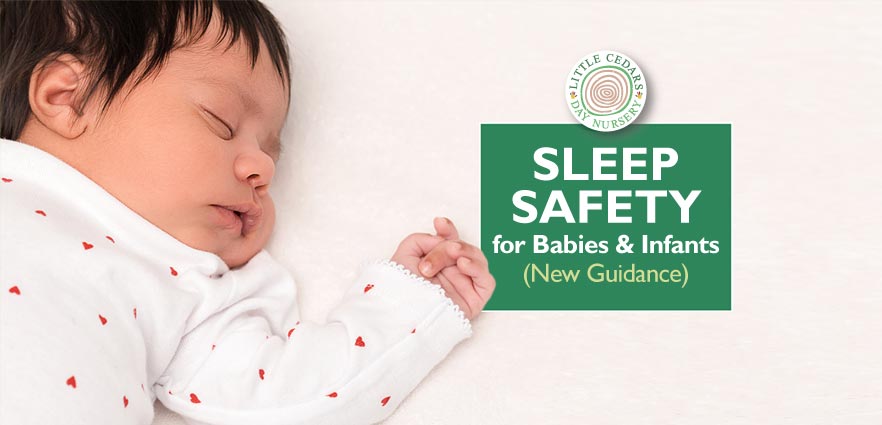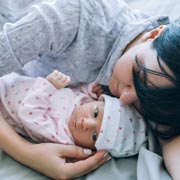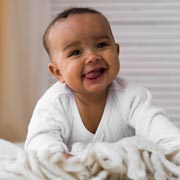
 June 2022 has seen the release of a new set of recommendations that outline ways to reduce the likelihood of sleep-related deaths amongst babies and infants up to the age of 1. This includes, but is not limited to, deaths related to Sudden Infant Death Syndrome (SIDS). Sadly, SIDS and other sleep-related issues are responsible for nearly 200 infant deaths in the UK each year and up to a staggering 3,500 every year in the United States. Perhaps even more surprisingly, that last number has not reduced at all in the last 30 or so years. This new set of recommendations from experts in the U.S. aims to change that and is something that all parents need to take a look at if they have a baby or infant. Let’s take a look at the new guidance …
June 2022 has seen the release of a new set of recommendations that outline ways to reduce the likelihood of sleep-related deaths amongst babies and infants up to the age of 1. This includes, but is not limited to, deaths related to Sudden Infant Death Syndrome (SIDS). Sadly, SIDS and other sleep-related issues are responsible for nearly 200 infant deaths in the UK each year and up to a staggering 3,500 every year in the United States. Perhaps even more surprisingly, that last number has not reduced at all in the last 30 or so years. This new set of recommendations from experts in the U.S. aims to change that and is something that all parents need to take a look at if they have a baby or infant. Let’s take a look at the new guidance …
“…simple is best: babies should always sleep in a crib or bassinet [static cradle], on their back, without soft toys, pillows, blankets or other bedding.”
According to the new 2022 report, parents and carers of babies/infants should follow the following guidelines:
Things to Avoid:
| Avoid smoking, drinking alcohol, opioids and the taking of illicit drugs during and after pregnancy. |
| Avoid allowing infants to sleep on their side and never let them sleep face-down. Some parents may have concerns about their child choking when placed (rightly) on their backs when sleeping, particularly if they suffer from gastroesophageal reflux (GER). However, the latest guidance explains how the child’s anatomy protects against choking and this is best explained in a short video. |
| Avoid sharing your bed with a baby or infant. Statistically, infants are at significantly greater risk of SIDS or injury in a shared bed. The AAP, authors of the new guidance, even go as far as saying that they do not support the practice under any circumstances. |
| Co-bedding (bed sharing) by twins, triplets, etc. is not recommended and the new guidance says that any perceived benefit of siblings co-bedding is simply outweighed by the risks. |
| Avoid the use of crib ‘bumpers’ because infants can roll against these, get into breathing difficulties and even die from lack of oxygen (as has sadly happened). |
“Loungers and pillow-like products are not safe for infant sleep, due to the risk of suffocation,” (CPSC)
| For exactly the same reason, avoid the use of blankets and any kind of pillow, including those not intended for sleep. Indeed, some ‘Boppy’ pillows and ‘loungers’ have been recalled after being linked to the death of several infants, according to USA Today(∞). The Consumer Product Safety Commission (CPSC) has also issued warnings about Podster, Podster Plush, Bummzie, and Podster Playtime infant loungers.(∞) |
| In regard to soft bedding, avoid putting weighted blankets, sleepers, swaddles or anything else that’s weighted in or near to a sleeping infant. |
| Avoid the use of inclined ‘sleepers’ and rockers for sleeping infants — or anything that puts the infant into an inclined or scrunched-up position. An incline may cause the child to roll and then get into breathing difficulties. That could potentially prove fatal due to suffocation. The U.S. Consumer Product Safety Commission (CPSC) and latest guidance advises that you should never allow a baby to sleep on an incline of more than 10 degrees. |
“Keep soft objects, such as pillows, pillow-like toys, quilts, comforters, mattress toppers, fur-like materials, and loose bedding, such as blankets and non-fitted sheets, away from the infant’s sleep area to reduce the risk of SIDS, suffocation, entrapment/wedging, and strangulation.”
| Also avoid allowing infants to sleep routinely in car seats, strollers, infant carriers or slings and similar and certainly never leave them unattended in them. |
| The new guidance also states that couches and armchairs are particularly dangerous places for infants to sleep, so should be avoided. Data suggests that the risks to infants are anywhere from 22 to 67 times greater when they’re allowed to play or sleep in such places. |
| Avoid putting hats on your infant indoors as it could cause overheating. Exceptions, however, include possible use during the first few hours of life (under close supervision) or if deemed necessary by medical professionals, e.g. for new born intensive care. |
| The new guidance also suggests that parents should not rely on heart rate and pulse oximetry monitors as marketed to consumers. These, they say, may not meet the same standards as their professional, medical counterparts. Moreover, possible complacency stemming from use of such monitors in place of following the other proactive guidelines may ironically — and potentially tragically — turn out to be more detrimental to their infant’s wellbeing. |
Things to Do:
| Ensure the baby/infant sleeps on a flat, firm, non-inclined surface, lying in the ‘supine’ position (on their backs). Sleeping flat, on their backs allows optimum intake of oxygen and is also the best sleeping position for development of spine and hips. A completely flat surface also makes it less easy for a child to raise/flex their trunk and lift their head, which may otherwise make it easier for them to roll onto their side or back, each of which would represent a higher risk to their wellbeing. |
| Ensure bedside sleepers, cribs, bassinets (static cribs) and suchlike are suitably sized and adhere to your country’s safety guidelines. They should also have a tightly fitting crib mattress (so the baby cannot get trapped in a gap), covered by a secure, fitted sheet with no other bedding or objects around. |
| Instead of using quilts, swaddles, sheets or blankets to keep your baby or infant warm when sleeping (such things are potentially dangerous to them), dress them in appropriate clothing layers when sleeping or use ‘wearable blankets’ that fit in place around their bodies — but which, critically, cannot rise over their heads/faces or otherwise entrap or strangle them. |
| The new guidance also recommends that infants sleep in the same room as parents, on a separate (flat) surface that’s designed for infants, close to their bed. This should be for a minimum of 6 months ideally and evidence suggests that this alone could reduce the risk of SIDS by as much as 50%. |
| Offering the baby/infant a pacifier encourages the tongue to move to a forward position, which reduces obstruction in breathing. Pacifiers also encourage babies to remain sleeping on their backs. It is indeed a measure that’s associated with reduced instance of SIDS, although the new guidance recommends that pacifiers are not offered until breastfeeding has been “firmly established”. |
| Where possible, human breast milk is recommended in preference to formula and is indeed associated with lower rates of SIDS. Furthermore, even better protection is achieved when infants are breast fed for a longer term. The new guidance recommends feeding human milk exclusively for the first 6 months when possible. |
| Other common sense precautions should be made, such as ensuring that there are no other hazards near the sleeping infant, for example, pull cords, window blind cords, electric wires, etc. |
 PLEASE NOTE: we have summarised key points from the new guidance in good faith but advise parents/carers of babies and infants to do their own research. More information and greater detail can be read in the full AAP publication here. If you have any concerns about your child’s sleep, health or wellbeing, please seek the advice of a doctor or health professional. You can also explore the importance of sleep for babies, toddlers and preschoolers in our guide, here.
PLEASE NOTE: we have summarised key points from the new guidance in good faith but advise parents/carers of babies and infants to do their own research. More information and greater detail can be read in the full AAP publication here. If you have any concerns about your child’s sleep, health or wellbeing, please seek the advice of a doctor or health professional. You can also explore the importance of sleep for babies, toddlers and preschoolers in our guide, here.
Looking for the Best Nursery or Pre-school in Streatham, Tooting or Balham?
Little Cedars Nursery and pre-school offers the highest quality childcare. Based in Streatham, it’s also convenient for weekday childcare near Furzedown, Tooting, Balham, Norbury & Colliers Wood.
 Are you looking for the best childcare nursery or pre-school in Streatham, close to Streatham Hill, Streatham Park, Streatham Common or Furzedown? Little Cedars offers a wonderful childcare service in Streatham and is also conveniently near to Tooting, Tooting Bec, Tooting Broadway, Tooting Common, Balham, Norbury and Colliers Wood. To arrange a tour of the setting, to apply for a nursery place, or simply to ask any questions, please get in touch and we’ll be delighted to help:
Are you looking for the best childcare nursery or pre-school in Streatham, close to Streatham Hill, Streatham Park, Streatham Common or Furzedown? Little Cedars offers a wonderful childcare service in Streatham and is also conveniently near to Tooting, Tooting Bec, Tooting Broadway, Tooting Common, Balham, Norbury and Colliers Wood. To arrange a tour of the setting, to apply for a nursery place, or simply to ask any questions, please get in touch and we’ll be delighted to help:

 June 2022 has seen the release of a new set of recommendations that outline ways to reduce the likelihood of sleep-related deaths amongst babies and infants up to the age of 1. This includes, but is not limited to, deaths related to Sudden Infant Death Syndrome (SIDS). Sadly, SIDS and other sleep-related issues are responsible for nearly 200 infant deaths in the UK each year and up to a staggering 3,500 every year in the United States. Perhaps even more surprisingly, that last number has not reduced at all in the last 30 or so years. This new set of recommendations from experts in the U.S. aims to change that and is something that all parents need to take a look at if they have a baby or infant. Let’s take a look at the new guidance …
June 2022 has seen the release of a new set of recommendations that outline ways to reduce the likelihood of sleep-related deaths amongst babies and infants up to the age of 1. This includes, but is not limited to, deaths related to Sudden Infant Death Syndrome (SIDS). Sadly, SIDS and other sleep-related issues are responsible for nearly 200 infant deaths in the UK each year and up to a staggering 3,500 every year in the United States. Perhaps even more surprisingly, that last number has not reduced at all in the last 30 or so years. This new set of recommendations from experts in the U.S. aims to change that and is something that all parents need to take a look at if they have a baby or infant. Let’s take a look at the new guidance … PLEASE NOTE: we have summarised key points from the new guidance in good faith but advise parents/carers of babies and infants to do their own research. More information and greater detail can be read in the full AAP publication here. If you have any concerns about your child’s sleep, health or wellbeing, please seek the advice of a doctor or health professional. You can also explore the importance of sleep for babies, toddlers and preschoolers in our guide, here.
PLEASE NOTE: we have summarised key points from the new guidance in good faith but advise parents/carers of babies and infants to do their own research. More information and greater detail can be read in the full AAP publication here. If you have any concerns about your child’s sleep, health or wellbeing, please seek the advice of a doctor or health professional. You can also explore the importance of sleep for babies, toddlers and preschoolers in our guide, here. Are you looking for the best childcare nursery or pre-school in Streatham, close to Streatham Hill, Streatham Park, Streatham Common or Furzedown? Little Cedars offers a wonderful childcare service in Streatham and is also conveniently near to Tooting, Tooting Bec, Tooting Broadway, Tooting Common, Balham, Norbury and Colliers Wood. To arrange a tour of the setting, to apply for a nursery place, or simply to ask any questions, please get in touch and we’ll be delighted to help:
Are you looking for the best childcare nursery or pre-school in Streatham, close to Streatham Hill, Streatham Park, Streatham Common or Furzedown? Little Cedars offers a wonderful childcare service in Streatham and is also conveniently near to Tooting, Tooting Bec, Tooting Broadway, Tooting Common, Balham, Norbury and Colliers Wood. To arrange a tour of the setting, to apply for a nursery place, or simply to ask any questions, please get in touch and we’ll be delighted to help:
